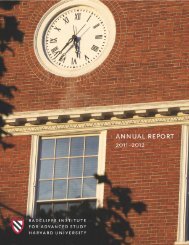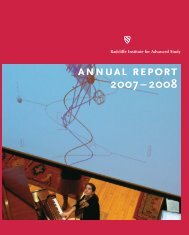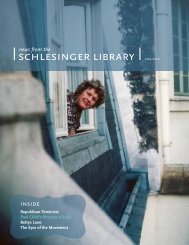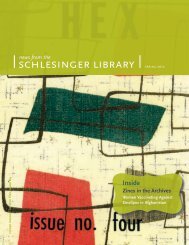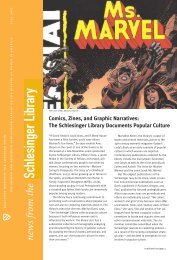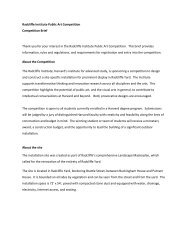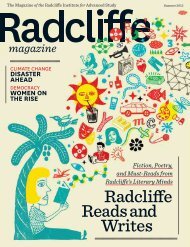Download - Radcliffe Institute for Advanced Study - Harvard University
Download - Radcliffe Institute for Advanced Study - Harvard University
Download - Radcliffe Institute for Advanced Study - Harvard University
Create successful ePaper yourself
Turn your PDF publications into a flip-book with our unique Google optimized e-Paper software.
V NEW BOOKS<br />
U<br />
Megan Marshall ’77, RI ’07, REVIEWER<br />
A fictional work that absorbs the power of<br />
Audacious Flights of Fancy<br />
Mary Coin: A Novel<br />
by Marisa Silver ’82<br />
Blue Rider Press,<br />
336 pp.<br />
Countless poems, novels, and even a handful<br />
of biographies have been inspired by<br />
iconic paintings. But few writers have thought<br />
to animate a photographic image. The medium’s<br />
apparent specificity—of subject, location, and<br />
time—must seem to <strong>for</strong>bid imaginative speculation.<br />
How could a snapshot, let alone the work of a professional documentary<br />
photographer, be “about” anything beyond what we see recorded by<br />
the camera’s eye<br />
In Mary Coin, her fifth work of fi<br />
ction, Marisa Silver takes not just one<br />
but many audacious flights of fancy in her thoroughly convincing improvi-<br />
sation on Dorothea Lange’s Migrant Mother. Silver’s daring is all the more<br />
impressive considering how much is known not only about Lange (the<br />
subject of an excellent biography, Dorothea Lange: A Life Beyond Limits, by<br />
Linda Gordon BI ’84, RI ’14), but about the family pictured in the photograph<br />
and the circumstances of the shoot. It would seem nothing more<br />
could be said about the two women who met on a Cali<strong>for</strong>nia roadside in<br />
the depths of the Depression, one holding a Graflex camera, the other an<br />
ailing infant in her arms.<br />
Yet in assigning all the principals new names, elaborating on and even<br />
inventing personalities, and conjuring up a plot linking a 21st-century<br />
divorced college professor and his family to the photograph, Silver has<br />
created a fictional work that absorbs the power of the original image and<br />
transmutes it into a multigenerational saga. Dorothea Lange becomes Vera<br />
Dare, and Florence Thompson becomes the title character, Mary Coin,<br />
whose route from Oklahoma in the 1920s to the Nipomo pea field of the<br />
1936 photo Silver traces in chapters alternating with Vera Dare’s progress<br />
from society photographer to documentary artist. The two women seem to<br />
share, through early loss, an awareness that “life was a feint, and that what<br />
people considered happiness was simply an avoidance of this grief.”<br />
One of the most pleasing aspects of the novel is its graceful insertion of<br />
commentary on the nature of Silver’s enterprise. Her history-professor<br />
protagonist Walker Dodge serves as mouthpiece: “He knows that any story<br />
told about what has happened in the past can never be certain, that there<br />
is always yearning in the piecing together of in<strong>for</strong>mation.” When, near<br />
the novel’s close, Walker reaches out to his disaffected teenage daughter,<br />
scarred more than he’d imagined by her parents’ divorce, in an ef<strong>for</strong>t to<br />
console, he tells her the “story” he has learned of Mary Coin, “some of it<br />
based on facts, some of it embellished, because he wants to keep her attention<br />
and he knows how stories need to go.”<br />
Paris Twilight:<br />
A Novel<br />
by Russ Rymer RI ’10<br />
Houghton Mifflin<br />
Harcourt, 304 pp.<br />
A medi-<br />
Acal team<br />
called to per<strong>for</strong>m<br />
an emergency<br />
heart<br />
transplant on<br />
an unnamed subject in an anonymous<br />
hospital in Paris; a mysterious bequest;<br />
an unexplained barnacle-like scar; an<br />
envelope containing old love letters<br />
from a wife separated from her husband<br />
during the Spanish Civil War—these are<br />
just a few of the conundrums presented<br />
to both reader and protagonist, the<br />
anesthesiologist Matilde Anselm, in<br />
Russ Rymer’s debut novel, Paris Twilight.<br />
With its ever-expanding cast of<br />
characters and chiaroscuro settings, the<br />
book calls to mind Howard Hawks’s film<br />
noir version of the Raymond Chandler<br />
novel The Big Sleep–except that Rymer’s<br />
characters “traffic in<br />
twilight” rather than<br />
darkness.<br />
Matilde, at least,<br />
suffers from a “radical<br />
ambivalence.” She cannot<br />
decide where to live,<br />
with whom to be in love.<br />
Her profession, which requires her to<br />
lead patients safely into the “middle<br />
realms” between life and death, suits<br />
her perfectly. “The thing that makes our<br />
human heart human,” she knows, “is<br />
its internal divisions,” both anatomical<br />
and figurative. That Rymer, a veteran<br />
journalist, can evoke the streets of<br />
Paris and its populace with impressive<br />
verisimilitude is no surprise; that he can<br />
set so complex a fiction in motion and<br />
bring it to a whirling, satisfying close is<br />
his true feat.<br />
Tiger Writing: Art,<br />
Culture, and the<br />
Interdependent Self<br />
by Gish Jen ’77, BI<br />
’87, RI ’02<br />
<strong>Harvard</strong> <strong>University</strong><br />
Press, 202 pp.<br />
One of life’s<br />
singular<br />
readerly delights<br />
is finding<br />
that a favorite<br />
writer has<br />
taken time out<br />
from creation<br />
to describe her craft. Such books can<br />
offer useful tricks of the trade, com<strong>for</strong>t-<br />
ing anecdotes of struggle and triumph,<br />
30 radcliffe magazine Summer 2013



